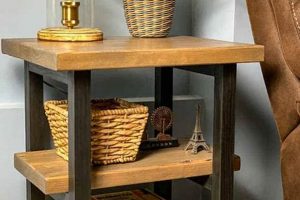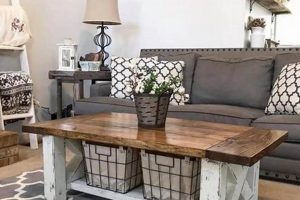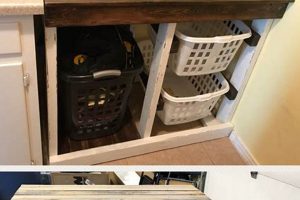A project involving the construction of a fold-down table, undertaken by an individual, signifies a “do-it-yourself” approach to space-saving furniture. An example would be building a wall-mounted table that can be stowed away when not in use, thereby maximizing floor area in a confined space.
This type of project allows for customizable solutions tailored to specific spatial requirements and aesthetic preferences. Historically, self-sufficiency in furniture creation provided cost savings and the opportunity to develop practical skills. This approach offers a sense of accomplishment and can result in a unique, personalized furnishing.
The following sections will delve into essential considerations for undertaking such a project, including design principles, material selection, construction techniques, and safety precautions. This will provide a comprehensive guide to successfully creating a functional and aesthetically pleasing piece of furniture.
Essential Considerations for Fold-Down Table Construction
This section outlines key tips for achieving a successful outcome when building a fold-down table, focusing on practicality and longevity.
Tip 1: Precise Measurement and Planning: Accurate measurements of the available space are crucial. Develop a detailed plan, including dimensions, folding mechanism, and mounting hardware, prior to any cutting or assembly. This minimizes errors and waste.
Tip 2: Robust Hardware Selection: The folding mechanism is a critical component. Invest in high-quality hinges, latches, and support brackets capable of withstanding repeated use and substantial weight. Consider weight ratings and durability specifications.
Tip 3: Stable Wall Anchoring: The table’s stability depends on secure attachment to the wall. Utilize appropriate anchors based on the wall type (drywall, plaster, concrete). Distribute the load evenly across multiple anchor points to prevent stress on a single location.
Tip 4: Durable Tabletop Material: Select a tabletop material that is both aesthetically pleasing and resistant to wear and tear. Solid wood, plywood with a durable veneer, or laminate surfaces are viable options. Consider the intended use and potential for spills or scratches.
Tip 5: Smooth Folding Mechanism: Ensure the folding mechanism operates smoothly and locks securely in both the open and closed positions. Lubricate moving parts as necessary. Adjust the hinges to achieve a flush and stable surface when the table is deployed.
Tip 6: Safety Considerations: Implement safety features to prevent accidental folding. Include a locking mechanism to hold the table in the upright position when not in use. Round the edges of the tabletop to minimize the risk of injury.
These guidelines emphasize the importance of meticulous planning, quality components, and safe construction practices. Adhering to these tips will enhance the functionality, durability, and safety of the fold-down table.
The subsequent section will explore common design variations and customization options for fold-down tables.
1. Space Optimization
Space optimization constitutes a primary driver in the execution of projects involving fold-down tables. In constrained living environments, a conventional table occupies a significant footprint, even when not in use. This leads to inefficient utilization of available square footage. The fold-down table, by virtue of its collapsibility, directly addresses this inefficiency.
The cause-and-effect relationship is evident: limited space necessitates innovative solutions, and a fold-down table serves as a direct response. The importance of space optimization within the fold-down table design process cannot be overstated. The dimensions of the room dictate the size of the table, and the folding mechanism is determined by the available wall space. Real-life examples include studio apartments, small kitchens, and home offices where such tables free up floor area for other activities when not required for dining or work. A kitchen island that folds down against the wall when not in use is a common instance, creating more space for meal preparation.
Understanding this connection is practically significant for several reasons. It informs design decisions, ensuring the table is appropriately sized and configured for the intended space. It highlights the importance of selecting durable and reliable hardware that can withstand frequent folding and unfolding. Furthermore, it underscores the need for careful installation to guarantee stability and prevent accidents. In conclusion, space optimization is not merely a benefit of fold-down tables but rather a core principle driving their design, functionality, and overall utility. Challenges may arise in adapting the design to accommodate specific space constraints or aesthetic preferences, but the fundamental goal remains consistent: to maximize usable area in a practical and efficient manner.
2. Mechanism Reliability
The successful implementation of a fold-down table hinges significantly on the reliability of its folding mechanism. This mechanism, encompassing hinges, latches, support structures, and any associated hardware, directly dictates the table’s functionality and longevity. The interplay between design and hardware integrity constitutes a critical determinant of the project’s overall success.
Mechanism reliability serves as a cornerstone within the context of a “do-it-yourself” fold-down table endeavor. The choice of materials, construction techniques, and hardware components all contribute to the overall performance and lifespan of the folding mechanism. For instance, the use of low-grade hinges may lead to premature wear, instability, and eventual failure, compromising the table’s usability and potentially posing a safety hazard. Conversely, robust, high-quality hardware ensures smooth operation, structural integrity, and prolonged service life. Examples abound in both residential and commercial settings where unreliable folding mechanisms have rendered fold-down tables unusable or even dangerous, highlighting the practical significance of selecting durable and well-engineered components. Consider, for example, a fold-down desk in a home office; repeated daily use necessitates a robust and reliable mechanism to withstand the stress of frequent folding and unfolding.
In conclusion, mechanism reliability represents an indispensable facet of fold-down table construction. The selection of appropriate hardware and meticulous attention to the assembly process directly contribute to the table’s functionality, safety, and longevity. While challenges may arise in sourcing suitable components or executing complex designs, prioritizing mechanism reliability remains paramount to achieving a successful and enduring result.
3. Material Durability
Material durability represents a critical factor influencing the longevity and functionality of a fold-down table project. The selection of materials directly impacts the structure’s ability to withstand regular use, weight-bearing demands, and environmental factors. In the context of a “do-it-yourself” project, the choice of durable materials is not merely an aesthetic consideration, but a fundamental requirement for ensuring the table’s long-term viability. The cause-and-effect relationship is straightforward: inadequate material strength results in premature wear, structural failure, and potential safety hazards. Real-life examples include tabletops warping under moderate weight due to the use of low-density particleboard or hinges failing due to the selection of substandard metals. The practical significance of understanding this connection is paramount; it necessitates informed material selection based on the table’s intended use and load capacity.
Consider, for instance, the selection of wood for the tabletop. Solid hardwoods, such as oak or maple, offer superior strength and resistance to warping compared to softwood alternatives like pine. Plywood, while more affordable, should be of a high grade with multiple plies to provide adequate support and prevent sagging. Similarly, the selection of metal hardware, including hinges, latches, and support brackets, demands careful consideration. Stainless steel or powder-coated steel offer enhanced corrosion resistance, crucial for environments with high humidity or frequent cleaning. The fasteners used for assembly, such as screws and bolts, must also be chosen based on their load-bearing capacity and resistance to loosening under stress. Furthermore, the finish applied to the tabletop influences its resistance to scratches, stains, and moisture damage.
In summary, material durability is an indispensable component of successful fold-down table construction. The judicious selection of materials, based on their strength, resistance to wear, and environmental suitability, directly contributes to the table’s longevity, functionality, and safety. While challenges may arise in balancing cost considerations with durability requirements, prioritizing material quality is essential for achieving a robust and reliable final product.
4. Mounting Security
Mounting security constitutes a non-negotiable aspect of fold-down table construction. The stability and safety of the entire structure depend on the integrity of its attachment to the wall. Insufficient mounting security poses a significant risk of structural failure, potentially leading to property damage or personal injury. Therefore, careful consideration of mounting methods and hardware is paramount.
- Wall Type Assessment
Accurate identification of wall composition is essential for selecting appropriate mounting hardware. Drywall, plaster, concrete, and wood framing each require specific anchor types to ensure a secure connection. Incorrect anchor selection can result in inadequate weight support and eventual detachment. For instance, using drywall anchors in concrete will lead to failure, as will relying solely on screws into drywall without proper anchors.
- Anchor Selection and Load Capacity
Choosing anchors with sufficient load capacity is critical. The weight of the table, including its maximum anticipated load, must be factored into the anchor selection process. Overestimation of load capacity is preferable to underestimation. Expansion bolts, toggle bolts, and sleeve anchors are common options, each offering varying degrees of support. Consulting manufacturer specifications is recommended to ascertain the safe working load of each anchor.
- Secure Attachment Technique
Proper installation technique is as important as the anchor selection itself. Over-tightening or under-tightening fasteners can compromise the anchor’s holding power. Ensuring that anchors are properly seated within the wall and that fasteners are fully engaged is essential for maximizing stability. Distributing the load across multiple anchor points is recommended to prevent concentrated stress on any single point.
- Regular Inspection and Maintenance
Even with proper installation, regular inspection of the mounting hardware is necessary to identify any signs of loosening or deterioration. Visual checks for rust, corrosion, or movement are crucial. Periodically tightening fasteners and replacing damaged hardware can prevent catastrophic failure. Neglecting routine maintenance can undermine even the most robust mounting system.
The aforementioned facets of mounting security are inextricably linked to the success of any fold-down table project. Inadequate attention to wall type, anchor selection, installation technique, or maintenance can compromise the stability and safety of the structure, negating the benefits of a space-saving design. Adherence to best practices in mounting security is therefore essential for ensuring a reliable and long-lasting fold-down table installation.
5. Design Customization
Design Customization, in the context of a “do-it-yourself” fold-down table, signifies the adaptation of standard construction plans to meet individual needs and aesthetic preferences. This personalization process extends beyond mere cosmetic changes, influencing functionality, spatial integration, and overall user experience. The degree of customization reflects the skill and resourcefulness of the individual undertaking the project.
- Dimensional Adaptation
Dimensional Adaptation involves altering the table’s length, width, and height to suit a specific space or intended purpose. A compact apartment may necessitate a smaller table surface than a larger home office. Adjustments to the table’s height can accommodate users of varying statures or align with existing furniture. Failure to adequately adapt dimensions can result in a table that is either too large for the available space or ergonomically unsuitable. Examples of dimensional adaptation range from modifying a standard design to fit within an alcove to creating a taller table for use as a standing desk.
- Functional Integration
Functional Integration refers to incorporating additional features into the fold-down table to enhance its utility. Examples include integrating storage compartments, incorporating charging stations for electronic devices, or adding a built-in whiteboard surface. This customization optimizes the table’s functionality for specific tasks or environments. A fold-down desk might incorporate shelving for books and supplies, while a fold-down kitchen table could include a slide-out cutting board. The practical implications of functional integration involve maximizing space utilization and streamlining workflow.
- Material Selection and Aesthetics
Material Selection and Aesthetics pertain to the choice of materials and finishes to align the table’s appearance with the surrounding dcor. This aspect of customization allows for the creation of a unique and visually appealing piece of furniture. Options range from selecting specific wood types and stains to incorporating decorative hardware or applying custom paint finishes. A modern interior may call for sleek metal accents and a minimalist design, while a rustic setting could benefit from reclaimed wood and wrought iron hardware. The aesthetic choices contribute significantly to the table’s overall integration into the existing environment.
- Mechanism Modification
Mechanism Modification involves altering the standard folding mechanism to suit specific requirements. This might include adapting the hinge type, incorporating a gas spring for smoother operation, or adding a locking mechanism for enhanced safety. A heavy tabletop might require stronger hinges or a gas spring to facilitate easier lifting and lowering. A table intended for use by children could benefit from a locking mechanism to prevent accidental folding. These modifications enhance the functionality and safety of the folding mechanism.
The described facets of design customization highlight the inherent adaptability of “do-it-yourself” fold-down table projects. The ability to tailor dimensions, integrate functional elements, select appropriate materials, and modify the folding mechanism allows for the creation of a truly personalized and space-efficient piece of furniture. The degree of customization depends on the individual’s skill level, available resources, and specific design objectives.
Frequently Asked Questions
This section addresses common inquiries regarding the planning, construction, and implementation of fold-down table projects.
Question 1: What tools are essential for constructing a fold-down table?
Essential tools include a measuring tape, level, stud finder, drill, circular saw (or hand saw), sandpaper, and appropriate safety gear (eye protection, dust mask). Additional tools may be required depending on the design complexity and material choices.
Question 2: How does one determine the appropriate size for a fold-down table?
The dimensions of the table should be determined based on the available space and intended use. Measure the designated area and consider the number of individuals who will be using the table simultaneously. Ensure sufficient clearance for comfortable seating or standing.
Question 3: What type of wall is suitable for mounting a fold-down table?
Fold-down tables can be mounted on various wall types, including drywall, plaster, and concrete. However, the appropriate mounting hardware must be selected based on the specific wall composition to ensure structural integrity. Consult with a hardware professional if unsure.
Question 4: How can one ensure the stability and safety of a fold-down table?
Stability and safety are paramount. Utilize robust mounting hardware, securely anchor the table to wall studs (when possible), and implement a reliable locking mechanism to prevent accidental folding. Regularly inspect the mounting hardware for any signs of loosening or wear.
Question 5: What are the most common challenges encountered during fold-down table construction?
Common challenges include inaccurate measurements, selecting inappropriate mounting hardware, ensuring a smooth folding mechanism, and achieving a level tabletop surface. Thorough planning and careful execution are essential for mitigating these challenges.
Question 6: What safety precautions should be observed during a DIY fold-down table project?
Safety precautions include wearing appropriate safety gear (eye protection, dust mask, gloves), using power tools responsibly, ensuring a stable work surface, and following manufacturer instructions for all hardware and materials. Avoid working when fatigued or distracted.
The information provided addresses fundamental aspects of fold-down table construction. Careful planning and adherence to safety guidelines are crucial for a successful outcome.
The subsequent section will provide guidance on sourcing materials and selecting appropriate hardware for the project.
Conclusion
This exploration of murphy table diy underscores the project’s potential for space optimization and personalized furniture creation. The discussion highlighted the necessity of precise planning, robust hardware selection, secure mounting techniques, and durable material choices. Furthermore, it emphasized the importance of adhering to safety precautions throughout the construction process.
Successfully executing a murphy table diy project requires a commitment to detail and a willingness to adapt standard plans to individual needs. The resulting product represents a functional and aesthetically integrated addition to the living space. Continued adherence to established best practices will enhance the project’s longevity and ensure its sustained contribution to spatial efficiency.







